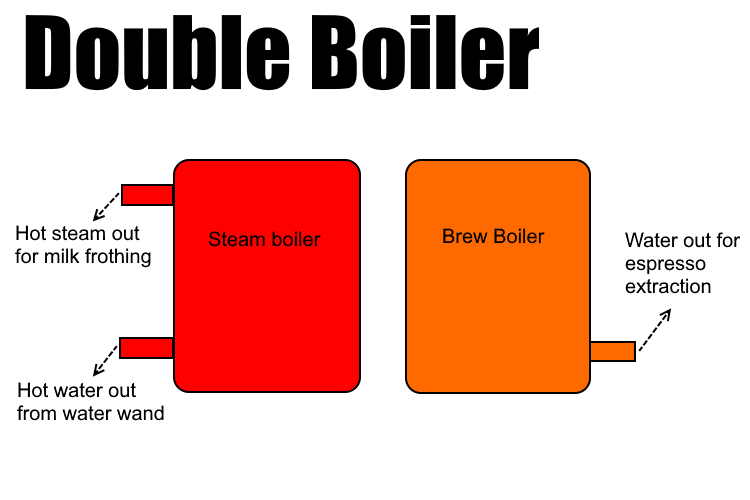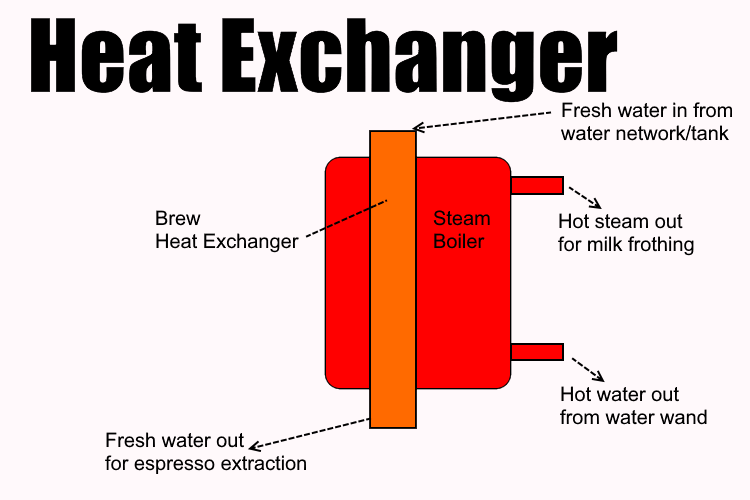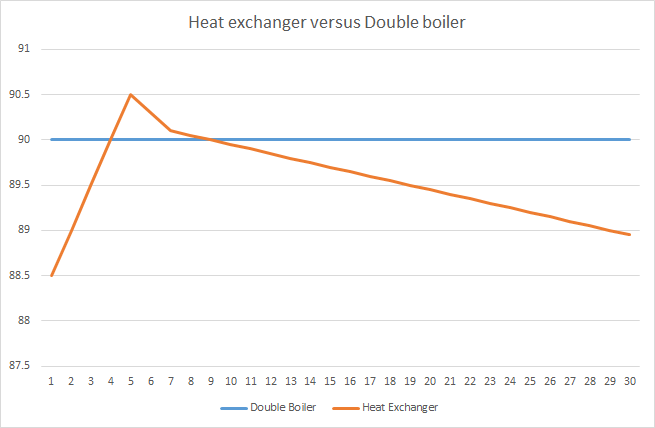A common question raised by many, “Should I get a double boiler or a heat exchanger?”.
In many cases, it depends on the user’s consumption level and expectations.
This is the double boiler.

A double boiler has two boilers in a single machine, each for a function. One will be the brew boiler, set at a lower temperature. One will be the steam boiler which is at a much higher temperature. The steam boiler is also known as a service boiler, used for producing steam for frothing or hot water for various purposes.
By having them separate, the user will have complete control of the brew temperature and is more consistent in the extraction.
This is the heat exchanger.

The heat exchanger has only one boiler, set at steam temperature. It has another smaller “boiler” inside, a heat exchanger rod that passes through.
When an extraction is required, the pump will push cold and fresh water from the water source, and pass through the heat exchanger rod. By algorithm of thermodynamics and hydrodynamics, as the water travels along the heat exchanger rod, the water heats up. The water should have heat to a therearound sweet spot of temperature, perfect for espresso extraction as it exits.
This is an example of a heat profile comparing both systems.

From the first look, we can understand that the double boiler should have a stable straight-line temperature. As there’s a dedicated boiler for its purpose. Whilst heat exchanger should expect some fluctuations, as cold water heats up as it enters the boiler, and the cold water cools the boiler down as more water passes through. If the heat exchanger boiler is large enough, the temperature decline should recover in seconds after the extraction. This maintains better consistency in dealing with shots made back-to-back,
So the question is, which is better?
Shouldn’t double boilers be better with consistent and accurate temperature control?
We must first understand the heating system’s history and coffee’s science to answer that. The double boiler was invented later than the heat exchanger and was popular in American cafes. The Americans were expanding quickly around the nation, so they did not have sufficiently trained baristas. They need a machine that is easy for any amateurs to make consistent shots.
Taste difference?
Is a straight-line profile better in taste? Before that, we refer to the definition of a good espresso. What else faithfully drinks espresso in the world other than the Italians?
This is their definition according to the Istituto Nazionale Espresso Italiano.
On sight, Italian Espresso has a hazelnut-coloured froth, verging on dark brown with tawny hinges. This cream has a very fine texture, which means that its mesh is tight and large or small bubbles are absent. The nose reveals an intense scent with notes of flowers, fruits, toasted bread and chocolate. All of these sensations are felt also after swallowing the coffee in the long lasting aroma that remains for several seconds, sometimes even for minutes. Its taste is round, substantial and smooth. Sour and bitter are well balanced and neither one prevails over the other. Astringency is absent or barely perceptible.
http://www.espressoitaliano.org/files/File/istituzionale_inei_hq_en.pdf
In short, the espresso should be well balanced, with acidity and bitterness, with a lovely blossom of the flavour of floral or fruity notes, along nutty profiles. Slight astringents can be seen as characterising the drink but not too much. It’s important not to mix up astringent and bitterness.
From many test taste, it’s found that heat exchanger releases a broader spectrum of characters that is closer to the criteria. Why is that so?
It’s long been known that pressure profiling machines and spring lever espresso machines are known for producing better-tasting espressos. They are never designed to be consistent with a straight-line brew profile. The pressure moves all the time. They are known to express a broader spectrum of flavours and tame the harsher astringents in espresso, which does match the above criteria from the Istituto Nazionale Espresso Italiano.
Heat and pressure play a similar effect. The higher the heat or temperature, the more energy it brings to the coffee during extraction. The higher the temperature or pressure, the more bitter and less sour the espresso gets. The heat that is hitting too high disintegrates the delicate flowery, and fruity aroma. So, a moving heat or pressure profile draws out a wider spectrum of flavours. At the same time, balancing the bitterness and sourness as it doesn’t stay at one point. It is also good for a machine to have a declining profile, as the second phase of the extraction, often after the 15th second, is more about adding volume than flavours. From that point on, the colloid from the lipid oil in the coffee starts to run out. These colloids are receptors of bitterness, and every bit more overwhelms the flavours in the coffee.
Water
What is the primary component of an espresso? It’s water. To Italians, many believe that fresh water is important for a good espresso. Many veteran baristas know that fresh water affects the taste of coffee. You can try the difference between fresh water and water that is stale.
Heat exchangers, only draw fresh water from the water network or water tank for their brew. So you can be sure that every espresso you make is done with fresh water.
Where does the double boiler draw water for making its espresso from? From its standalone brew boiler. Water in the brew boiler has no movement and gets reheated from the day it operates till the last time of its service. The only way to flush the brew boiler is to turn on your grouphead and flush out the water extensively. This is something unlikely you will want to do to freshen your water every day, so most users eventually stick to using the stale water from the boiler. To prevent a buildup of bacteria or microbial from nesting, most boilers are made of copper, which has natural anti-microbial properties. Double boilers made of stainless steel may require higher frequency for extensive overhaul or flushing of the boiler regularly, especially if the machine stays stagnant and was not heated for some time. As biofilm could be formed on the walls.
Steam for frothing
In most cases, the machine can only activate one heating element, heat either the steam boiler or brew boiler one at a time. Unless the machine uses a higher ampere or multiphase, as seen in commercial machines.
If the boiler for steam is smaller, it will collect less steam and be more unstable for extensive frothing. If you are drawing both coffee and steaming simultaneously or the timing is very close together, the temperature of one boiler will drop.
Maintenance
A heat exchanger only has one boiler to maintain. With one heating element, overheating safety sensor, overpressure safety controller, low water sensor, safety valves, etc.
With a double boiler, the number of parts to maintain will be increased and maintaining them will be both challenging and expensive. The chance of having something malfunctioning will likewise be increased.
Descaling a necessary cleaning procedure is much more complicated and requires professional assistance.
Startup time
For prosumer machines, having two boilers, the double boilers will, of course, take a longer time to heat up. As often, only one heating element works at one time. For many residential estates, powering two heating elements simultaneously will require too much ampere and require dedicated wiring. Only commercial machines that draw a considerable amount of electricity could overcome this.
A heat exchange E61 espresso machine can get properly heated up in 20 minutes; a double will require at least 30 minutes. Machines like the Bezzera BZ line, can get heated up in 12 minutes. That’s due to the small heating element placed at the grouphead.
Are you aware that Italy Forbes has recognised one particular Italian coffee brand to be of the utmost excellence?
It is not one of those highly marketed coffee by some celebrity barista. The company is the one and only coffee brand recognised by Forbes top 100 excellent products.
Created by the founder of the CSC certification which has the highest standard of coffee creation, from the plantation to the final product in its bag. Even higher standards that the common known Specialty Coffee Association.
Who also happens to be the international juror for the cup of Excellence. Which is the Oscars for coffee seen on the television or newspaper for the most premium expensive coffee auctioned off.
This is the absolute legend in coffee which everyone has never noticed.
Find out more from the following:
